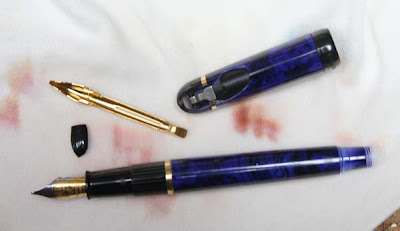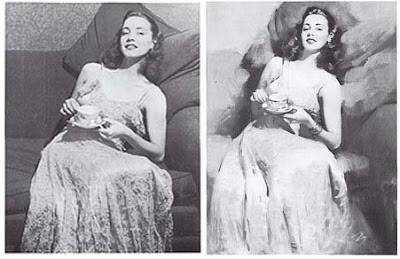
Just heard a scream from the laundry room upstairs. Looks like I left my fountain pen in a load of whites. It busted up and bled in the spin cycle. Now we'll be walking around covered in strange brown spots.



 11. Once you get your model (or yourself) in costume, you can take reference photos in a variety of poses. If it’s an easy pose to hold, you can work directly from the model. That's how I did the painting of Oriana above, which appears in Dinotopia: The World Beneath. I put pieces of tape on the floor to mark where the model's feet should return between breaks. The whole session only took about an hour and a half, which saved time over shooting reference or doing drawn studies.
11. Once you get your model (or yourself) in costume, you can take reference photos in a variety of poses. If it’s an easy pose to hold, you can work directly from the model. That's how I did the painting of Oriana above, which appears in Dinotopia: The World Beneath. I put pieces of tape on the floor to mark where the model's feet should return between breaks. The whole session only took about an hour and a half, which saved time over shooting reference or doing drawn studies.  Good costumes can be expensive to buy or rent. And they can be difficult to make. But having a real costume makes a huge difference in your finished work. You can tell right away if an artist just made up a costume or went to the trouble to get a real one.
Good costumes can be expensive to buy or rent. And they can be difficult to make. But having a real costume makes a huge difference in your finished work. You can tell right away if an artist just made up a costume or went to the trouble to get a real one. 
 To idealize the figure, he made the head of the model slightly smaller in the painting than it appeared in the reference.
To idealize the figure, he made the head of the model slightly smaller in the painting than it appeared in the reference.  This exhibition includes 92 paintings and drawings, along with sketchbooks. The London exhibition will continue through September 13, after which it will continue at The Montreal Museum of Fine Arts in Canada from October 1, 2009 – 7 February 2010.
This exhibition includes 92 paintings and drawings, along with sketchbooks. The London exhibition will continue through September 13, after which it will continue at The Montreal Museum of Fine Arts in Canada from October 1, 2009 – 7 February 2010.

 The antihelix curves inside the helix, separated by the groove called the scapha. It splits at the top into the superior and inferior crux or leg, with the triangular fossa in between.
The antihelix curves inside the helix, separated by the groove called the scapha. It splits at the top into the superior and inferior crux or leg, with the triangular fossa in between.  “You can forget everything else I taught you,” he tells them. “But I want you to remember just two things: how to place the horizon line, and how to draw an ear.”
“You can forget everything else I taught you,” he tells them. “But I want you to remember just two things: how to place the horizon line, and how to draw an ear.” Then the man said, “ Why that’s nuthin but puttin’ on daubs!”
Then the man said, “ Why that’s nuthin but puttin’ on daubs!”